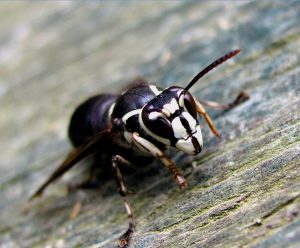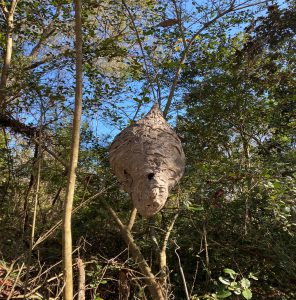Many folks are giddily decorating their homes for the holiday season. For some outdoor enthusiasts and/or environmental educators, now is the time to collect and preserve a natural decoration, with care. Hornet nests offer a large natural ornament that can be used as a conversation piece or to teach people about an interesting native wasp that is often feared.
The bald-faced hornet (Dolichovespula maculata) is a type of wasp closely related to yellowjackets, of which there are two species that are known from Florida, the eastern yellow-jacket (Vespula maculifrons) and southern yellowjacket (Vespula squamosa). The bald-faced hornet is different than its yellowjacket relatives in that it creates a large aerial nest rather than a subterranean nest. If you have seen a hornet’s nest in person, you know how impressive they can be. Surprisingly, they can be safely preserved for indoor display!
Hornet colonies begin each spring and are “founded” by a lone adult queen that made it through the winter, hiding under the bark of logs and such. The lone queen begins creating the papery brood cells and laying eggs. Once those eggs begin to hatch, the newly hatched all-female crew of hornets begin assisting in nest building and foraging while the queen shifts to only laying eggs. Towards the end of fall, some of the eggs receive more food (they become queens) and the queen also begins to lay male eggs. Once these emerge, they mate, and the cycle starts all over again, with the colony dying back, leaving an abandoned and impressive aerial nest behind.
To collect that impressive nest safely, wait until a couple of freezes have passed. At this point, most, if not all, of the hornets will have perished and that lone queen will be sheltering through the winter. Don’t wait too long since these nests are utilized by other wildlife and may be destroyed or get beaten up by the weather. Simply cut the nest off its support (realize it may be heavy). To be extra sure you don’t bring live hornets inside, you can leave the nest in a protected outdoor location, such as a garden shed or the garage, where it will be exposed to further cold temperatures. This also allows any “off” smells from rotting larvae to air out. Don’t worry about harming these larvae as they would starve either way since they must be fed by adult hornets! There is no need to use varnishes or polyurethanes for preservation as the nest will keep indefinitely as long as kept in a dry environment free from a lot of handling or vibrations.
Bingo, you now have a natural ornament that can last through many seasons and provide for learning opportunities and lots of conversation!
For more information on wasps, including hornets and yellowjackets, please see the Yellowjackets and Hornets EDIS document from UF/IFAS. Information from Iowa State University’s website Preserving and Displaying a Hornet’s Nest was also used to help write this article.
- Let Extension Diagnose Your Landscape Issues - May 28, 2025
- No Mow March 2025! - February 27, 2025
- New Year’s Resolution Ideas for Gardeners - January 16, 2025


